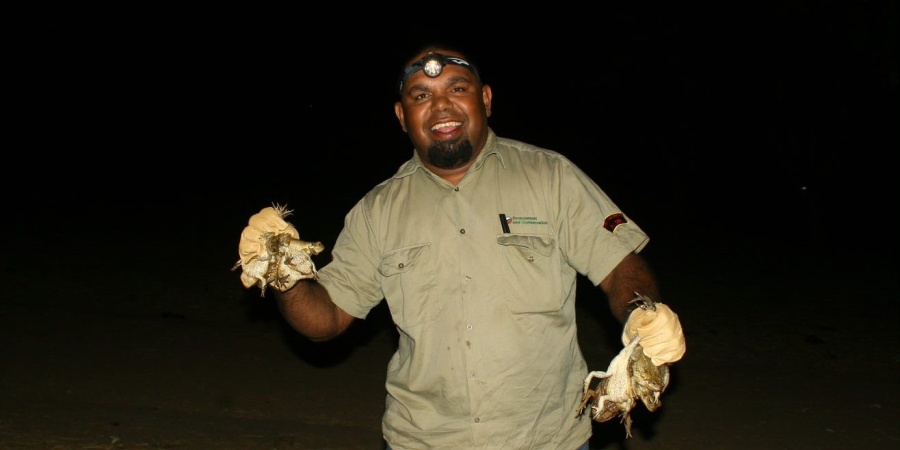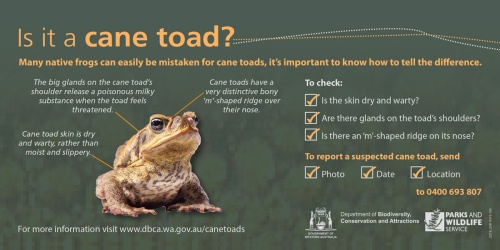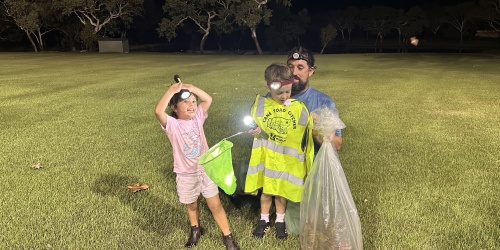
Cane toad management research partners
Innovative management approaches, including advancing technologies, are necessary for continuous improvements in cane toad management. Collaborating with research organisations and stakeholders fosters knowledge exchange and capacity building. Through this collective effort, we can tackle cane toad management issues effectively and adapt our approaches over time, fostering a culture of continuous learning and improvement.
Traditional owners and cane toad management
The Kimberley region includes nine Indigenous protected areas covering more than 9 million hectares, of which four link together to create the largest Indigenous-managed conservation corridor in northern Australia.
Each of these areas are managed by Traditional Owner ranger groups, who through their deep connection and extensive knowledge of their lands, possess invaluable insights into the presence and behavior of at-risk native species. Their wealth of intergenerational knowledge allows them to contribute significantly to the conservation efforts by combining traditional wisdom with contemporary scientific approaches. By incorporating cane toad management strategies into their activities, rangers aim to safeguard and enhance the region's rich biodiversity for future generations, ensuring the ongoing conservation of its high ecological values.
For example, over recent years, DBCA has collaborated with Dambimangari Aboriginal Corporation and Australian Wildlife Conservancy to monitor cane toads as they spread through Dambeemangarddee Country. Working together, the spread of toads has been mapped and the impact on the northern quoll populations monitored across the area. Conditioned taste aversion trials have been delivered to several key quoll populations on Dambeemangarddee Country.
DBCA supports its partners in a number of ways. One method we are currently working on is researching eDNA technology to create an affordable and portable test for detecting cane toads, especially in remote regions like the Kimberley islands. This will allow rangers and other land managers to collect field samples during routine monitoring and send them to the Perth laboratory from distant locations, while still obtaining reliable results.
Island biosecurity
Australia's offshore islands serve as refuges for several native wildlife species that have experienced significant declines and local extinctions on the mainland. Conservation managers are increasingly using these islands as safe havens for conserving populations of threatened species. Islands are natural refuges for native species because they are separated from the mainland, and therefore not as easily invaded by invasive animal species.
Islands in the Kimberley region, which are located within Indigenous Protected Areas, play a pivotal role in protecting native species from the impacts of cane toads. For example, the Dambimangari Indigenous Protected Area, which spans 1.4 million hectares of country in the Buccaneer Archipelago, includes a long coastline dotted with islands, rich with biodiversity.
The Balanggarra Indigenous Protected Areas covers one million hectares across land and sea in the remote far north Kimberley, and includes Cape Londonderry, the Cambridge Gulf, several rivers such as the lower Drysdale and King George, the Forrest River system and offshore islands, like Sir Graham Moore, the Governor Islands, and Adolphus Island.
If islands in the Kimberley remain cane toad-free, they’ll play an essential role in protecting the northern quoll's future viability. This is because many islands have self-sustaining populations that are protected from numerous threats present on the mainland.
To prioritise efforts, it is crucial to understand how cane toads are likely to reach and spread across Kimberley islands and which islands are most at risk. Initial research modelled complex information to make predictions about which Kimberley islands are most at risk of cane toad invasion over the coming years.
Woodamurra (Adolphus) Island long term monitoring project
Woodamurra is an island of significance to Balanggarra people as it is an important site for bats, so much so, that the island is also colloquially known as "Flying Fox Island" by some local residents. Traditionally, Balanggarra people would raft over to the island to hunt flying foxes. Bats, being easily hunted during the day, constituted a readily available source of protein for people of the area and were a much loved meal for Balanggarra people.
Woodamurra (Adolphus) Island, located in the Balanggarra Indigenous Protected Area, was invaded with cane toads in approximately 2012 when these toads reached the island through "rafteding" during flood events. This unique situation has provided researchers with a valuable opportunity to observe how native species cope with the presence of cane toads, especially considering the absence of permanent freshwater sources that would facilitate the spread of the toad population.
DBCA has formed a partnership with the Balanggarra Aboriginal Corporation which manages these lands, to closely monitor the impact of cane toads on the island's fauna. Rangers have been collecting long-term data on both the effects of cane toads on the native wildlife, and toad population dynamics. Woodamurra (Adolphus) Island is home to one of the last remaining populations of northern quolls in the East Kimberley region, and these quolls, along with native reptile species found on the island, are particularly vulnerable to the harmful effects of cane toads.
Remarkably, despite the risks these native species face on the mainland, the assemblage of wildlife on Woodamurra (Adolphus) Island has managed to survive.
You can read the ABC media article about how cane toads and native wildlife somehow coexist.
Industry
Industry funding plays a crucial role in protecting native animals vulnerable to cane toads by supporting various initiatives. Invasive animal management can be costly, requiring significant financial resources, and industries can assist by providing financial support through sponsorships, grants, or funding partnerships.
Funding from industry helps cover the costs of important activities such as cane toad musters, which contribute to producing cane toad bait sausages used in conditioned taste aversion. It also supports helicopter surveys to monitor and assess the spread of cane toads, ensuring a proactive approach to their management. Additionally, industry funding assists in covering laboratory costs, facilitating research and development efforts that are essential for safeguarding native species populations.





